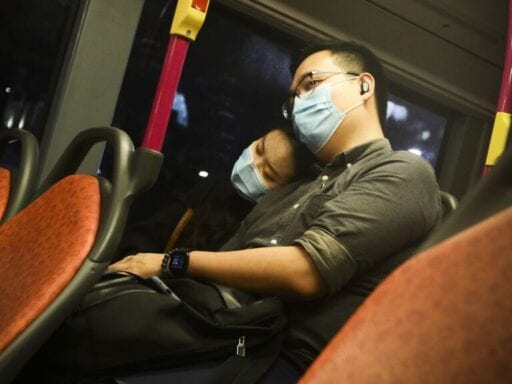A new study from Singapore shows how presymptomatic spread of coronavirus works.
One of the things that makes the novel coronavirus so challenging to contain is asymptomatic and presymptomatic transmission: If you’re infected, you can get someone else sick before you know that you have the disease.
As my colleague Julia Belluz reported, researchers in China found that people shed the most virus — potentially exposing others — just as they started to show symptoms, or even before. And in one case, someone had high levels of the virus without ever experiencing any symptoms themselves.
Since then, evidence has been accumulating that this presymptomatic or asymptomatic transmission is not just a possibility that shows up in the lab — it’s a major route by which the coronavirus spreads. The latest piece of evidence? A new study from Singapore paints the clearest picture yet of how people are getting each other sick before they even realize they’re sick themselves.
The researchers, who looked at all of the 243 confirmed coronavirus cases reported in Singapore between January 23 and March 16, found seven clusters of cases in which 10 infections were attributed to presymptomatic transmission. (To be clear, there were other cases they couldn’t trace at all, as well as cases where presymptomatic transmission couldn’t be ruled out, so this shouldn’t be taken to imply that only 6 percent of cases feature presymptomatic transmission.)
/cdn.vox-cdn.com/uploads/chorus_asset/file/19869614/GettyImages_1209052037.jpg) Zakaria Zainal/Anadolu Agency via Getty Images
Zakaria Zainal/Anadolu Agency via Getty ImagesThe case studies make one thing clear: Authorities can’t control the coronavirus outbreak just by quarantining sick people. They have to dramatically reduce contact among the rest of the population, too. Feeling good or having an absence of symptoms doesn’t mean you can’t infect someone else. And the recommendation to wear masks only when you’re sick just won’t cut it — which is why experts are reconsidering the advice to not wear them if you’re healthy.
Seven case studies of presymptomatic transmission
In the first cluster the researchers looked at, a wife and husband traveled on January 19 from Wuhan, China, to Singapore, where they visited a church the same day.
Three other people who attended church that day later developed symptoms. One of them came into the church after the couple had left but sat in the same pew, as seen in closed-circuit camera footage. “Investigations of other attendees did not reveal any other symptomatic persons who attended the church that day,” the study reads. The travelers from Wuhan had an onset of symptoms on January 22 and January 24, while the person who sat in their pew developed symptoms on February 3.
In the second cluster, a woman attended a dinner on February 15 and was exposed to someone with a confirmed case of Covid-19. She attended a singing class on February 24 and developed symptoms two days later; another woman at the same class developed symptoms three days after that.
In another three clusters, a person who had been exposed to Covid-19 went home and exposed the people they lived with; in all three cases, the initial patient and their wife, husband, or housemate developed symptoms on the exact same day (so the transmission must have happened before the symptoms started).
In the sixth cluster, a woman who’d been exposed to Covid-19 on February 27 went to church on March 1. She started showing symptoms on March 3, as did one of the people she’d likely infected at the church service. Another person who attended church that day started showing symptoms on March 5.
In the seventh cluster, a man who’d been exposed to Covid-19 met a woman on March 8. He started experiencing symptoms on March 9, and she on March 12.
There are some important caveats here. While Singapore has been very thorough in its contact tracing and case identification work, it’s always possible that one or more of these patients was actually infected by someone else.
“Given that there was not widespread community transmission of COVID-19 in Singapore during the period of evaluation and while strong surveillance systems were in place to detect cases, presymptomatic transmission was estimated to be more likely than the occurrence of unidentified sources,” the researchers wrote. But in any specific case, another exposure could not be categorically ruled out.
/cdn.vox-cdn.com/uploads/chorus_asset/file/19869620/GettyImages_1209027361.jpg) Suhaimi Abdullah/Getty Images
Suhaimi Abdullah/Getty ImagesThere’s also the potential for recall bias — especially in cases of mild illness — where people mistakenly misreport the day on which their symptoms began.
But even with those caveats in mind, the Singapore study is the latest contribution to an overall picture of the virus, corroborated by other data: People are likely getting each other sick while feeling perfectly healthy, leaving a trail of infections in their wake that they may not know they’re responsible for until several days later.
You can read the case studies in full — they’re not very long — but one takeaway, the researchers wrote, is this: “These findings … suggest that to control the pandemic, it might not be enough for only persons with symptoms to limit their contact with others.”
That’s one of the key things making the novel coronavirus more dangerous than SARS, which actually had a much higher infection fatality rate. You couldn’t pass on SARS until you were symptomatic, so quarantining sick people was enough to bring the outbreak under control. With the novel coronavirus, that’s simply not true.
In other words, even if you feel healthy, stay home. And if you have to leave the house, assume you might be sick and wear a mask — if you can get or make one without reducing their supply for health care workers.
Sign up for the Future Perfect newsletter and we’ll send you a roundup of ideas and solutions for tackling the world’s biggest challenges — and how to get better at doing good.
Future Perfect is funded in part by individual contributions, grants, and sponsorships. Learn more here.
Author: Kelsey Piper
Read More



